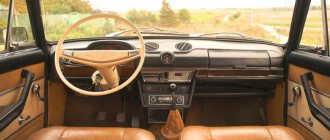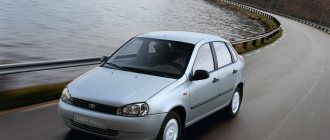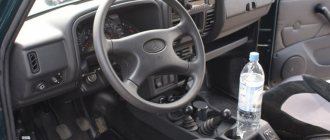Despite the fact that the Lada Priora has a completely modern appearance by today's standards, not all owners of this car are satisfied with its factory design. And in order to improve the appearance and add originality, many carry out external tuning (aka facelift). Only some elements of the car body are subject to changes, including optical instruments. Tuning headlights on a Priora is a fairly popular operation for changing the appearance of a domestic car. Let's consider the topic in more detail.
Eyelashes for headlights
“Ciliations” are the fastest and most inexpensive option to change the appearance of your car’s optical devices. “Eyelashes” are special linings that are glued to the top of the headlight glass. They can be of various shapes and widths, and can also be painted to match the body or simply black.
These headlight covers, since they are located at the top, do not affect the quality of illumination of the road surface. At the same time, they make the appearance of the car stylish and daring. You can make such extensions with your own hands or buy ready-made “eyelashes”.
Homemade tuning of headlights on a Priora is the most profitable option, since you can create linings of literally any shape with your own hands.
The work on disassembling the headlights of the Lada Priora takes place in several stages:
- The first and one of the most difficult stages is removing the headlight of the Lada Priora. This may even require separate step-by-step instructions. First, disconnect the block with wires from the headlight. Remove all headlight mounting bolts one by one. Remove the headlight housing and remove it from its socket.
- Now it's time to use a hair dryer. Heat it to a temperature of 250 degrees and start processing the joint. Heat the glue evenly around the entire circumference of the headlight until it begins to melt.
Note! Before “melting” the headlight, some “masters” recommend cutting off the plastic edge that runs along the entire circumference of the headlight with a knife. Although this greatly simplifies the process, it is not at all necessary to cut off the side; it will be enough to just bend it slightly. If the joint is well heated, opening the headlight usually takes place without complications. It's not worth damaging the headlight housing for this.
- After a good warm-up, try to carefully separate the front part of the headlight. At the same time, continue to heat the entire joint along the rim. If you come across Bosch headlights, you will additionally need to disconnect the four fixing brackets.
- When the glass is completely removed from the headlight housing, clean the joints. There will probably be traces of already hardened sealant on them. It is most convenient to clean with a utility knife and fine-grained sandpaper.
- Next, carry out the repairs for which the headlight was opened. Reassemble the headlight in reverse order.
- To glue the headlight glass back to the body, apply sealant to both halves. Press both parts of the headlight firmly.
- To ensure that the gluing is as strong as possible without any gaps, wrap both halves of the headlight with cling film. Wrap the parts with tape over the film. This is a proven way to fix both halves of the headlight for a certain time required for the sealant to polymerize. The cling film will not leave marks on the headlight after removal, as would be the case if it was simply fixed with tape.
After gluing the headlight, install it in place. Now everything will work as it should.
Also read with this article:
Step-by-step instructions for replacing the cabin filter on your Lada Priora yourself
We change the steering tips of Lada Priora
Replacing the air filter Lada Priora
Step-by-step instructions for soundproofing the floor of a Lada Priora with your own hands
Coloring masks
The next type of tuning the appearance of optical devices is painting the Priora headlight masks. These changes are also not expensive and will not hurt the car enthusiast’s pocket. The mask is a specific insert that is placed inside the headlight structure. The factory version of the mask is chrome-plated. After painting the mask (traditionally black), the appearance of the car will change quite seriously. Therefore, this tuning of headlights on Priora is quite common.
However, there is a difficulty in its implementation, which lies in the need to completely disassemble the lighting device. Since the Priora's headlights are not dismountable, the glass is securely glued to the body using sealant. However, with the right approach, disassembly can be done. After this, the mask is removed from the headlight, cleaned (the chrome coating is removed), primed and painted. Then the lighting fixture is put back together and installed in its original place.
studio
atelierTuning Priora headlights in the style called “angel eyes” requires not only dismantling the headlight, but also disassembling it.
This will allow you to wear out the “eyes” and tint the surface of the reflector (mask, blender) using black paint. List of materials and tools required to complete the work:
- masking tape, which allows you to preserve the glass during dismantling;
- to remove the blender - a screwdriver with a T20 tip;
- technical hair dryer;
- black spray paint;
- plastic tube;
- a set of LEDs with corresponding resistors;
- aluminum tape;
- glue;
- hacksaw for metal;
- automotive sealant.
Installing lenses in headlights
Today, there are a lot of car enthusiasts who install other lenses in their headlights. Such elements in factory lighting devices are mounted in optics for the following purposes:
- As a tuning for Priora headlights and rear instruments. Most people like the look of lighting fixtures with lenses. Most often, they can have “angel eyes” in their design, an LED rim around the lens.
- Lenses are installed together with xenon lamps. If you install xenon at certified service stations, then it is supplied only with lenses.
- Standard installation from the factory. In this situation, lenses are often installed by the manufacturer in expensive models. And the lighting devices in such cars are already a whole computer, they have a lot of functions and even have cornering lights.
Lensed headlights on a Lada Priora are probably the most expensive way to carry out a facelift. It consists in replacing factory optical devices with lensed optics.
Installation of LED DRLs
LEDs for replacing daytime running light bulbs must comply with GOST. They provide excellent light during daylight hours, and if connected correctly, light up when the ignition is turned on.
The connection is made through a five-pin relay; plastic corrugations can be used to insulate the wires. Each LED block will have a black and a red wire coming from it. It is advisable to connect the black one to the windshield wiper fuse F11 (20), and the red one to the left side light fuse F14(5).
The use of LED DRLs instead of factory ones after the first week will change the Priora owner’s view of his own car. Such a small part can cost about 500 rubles for two lights, but its appearance on the road will be noticeable to everyone.
"Angel Eyes"
Changing the configuration is not a particularly expensive method of tuning Lada Priora headlights. Such optical devices began to be used for the first time on BMW cars, but this does not prevent them from being mounted on the model under study. Moreover, the shape of the lighting elements fully allows this to be done. “Eyes” refer primarily to side lights. They are special rings that are installed around the perimeter of the reflectors. They glow with a beautiful “cold” bluish light.
Some car enthusiasts manage to make “angel eyes” on the Lada Priora on their own, for which they use silicone tubes or special plexiglass rods, as well as LEDs. You can buy ready-made devices in automobile accessory stores.
Warnings against breaking the law
Tuning the optics of the Lada Priora seems simple at first glance. But in fact, in order to avoid problems during a technical inspection, it is recommended to know the GOST standards. The main features of the optics upgrade are listed below:
- If you plan to install new lamps on the front or rear headlights, then you must definitely check the documentation for the product. It should indicate that such lighting means can be used in Russia.
- You can install new light bulbs in half an hour, but don’t forget about the settings. The corrector will help you set the desired direction of the headlights. The corrector must be in good working order, since incorrectly setting the light can lead to a decrease in the safety rating and problems with the law.
If you do not plan to carry out tuning using more powerful lamps, then you can use your imagination. Legislation allows the installation of various optics on car lighting devices, for example, LED strips.
Headlight tinting
Tuning "Priora" rear lighting and front optics using tinting is carried out in several ways - using special paint or a tinting membrane. What color film to choose is decided solely by the car enthusiast. The most common and classic color is black. However, when tinting, a film that matches the color of the car body can be used. It is important to remember that tinting headlights leads to a deterioration in the light output and reduced visibility on the road in the evening and at night.
Adjusting headlights using a corrector
You can make adjustments without disassembling the head optics. On the back of the headlight you will find adjustment screws that can be used to lower and raise the light beam. To set it up, you will need to place the Lada Priora on a flat surface opposite a wall or garage - the distance from the headlights to the wall should be 5 meters. Also check whether the corrector is working or not. It is recommended that a person of similar build sit in the driver's seat during the inspection.
Headlight polishing
During travel, factory lights are exposed to the negative effects of sand, gravel, dirty water that fly off from nearby passing vehicles, as well as the chemical action of road reagents and salt. Because of this, the surface of the headlights acquires a yellowish tint, becomes matte, and the intensity of the luminous flux decreases. At night, visibility deteriorates.
Modern optical devices are made of polycarbonate, which means that to polish them you will not need to buy expensive diamond paste, which is comparable in cost to the price of new headlights. A budget abrasive will undoubtedly help improve the situation. Tools and materials that will be needed for self-polishing, that is, for tuning the Priora headlights and rear lights:
- scotch;
- sandpaper of different abrasiveness;
- grinding machine;
- car shampoo;
- polish;
- rags.
The polishing process is as follows:
- Clean the headlight well with shampoo and then degrease.
- Dry and tape nearby metal of the car body with tape to protect it.
- Initially, work the surface with a weak abrasive, and then with a coarser one. Each type of abrasive is used for 2-3 minutes.
- Wash the surface of the headlights thoroughly and dry it.
- Using a foam pad and polishing agent, polish to a high shine.
Making chameleon headlights
Want to make "chameleon lights"? Then use a special tint. You can purchase ready-made versions of the film without any problems at any automotive supply store. Their cost varies depending on the manufacturing company. The most budget-friendly one is from a Chinese manufacturer.
The film material is heated with a hairdryer and applied to a pre-wetted headlight. Smooth it well so that there are no folds or bubbles left. As a result of such tuning of the Priora headlights, the photo of which you see above, the car acquires very stylish optics.
Self-recovery methods
To get to the reflector, the headlight removed from the car must be disassembled. The first option involves repeatedly passing the hot air of a hair dryer over the seam. The second option involves leaving the headlight in an oven preheated to 100°C for 20 minutes. After opening, all parts are cleaned of sealant residues, washed without using alcohol-containing liquids and dried.
Using metallic tape
Let's start with how to restore the reflector on a headlight using tape foil. All you need is metallized tape, purchased at a hardware store for about 30 rubles. Its adhesive base copes well with high and low temperatures, and the aluminum film is very wear-resistant.
Advantages of the method: durability, low cost, ease of implementation.
Disadvantages: when gluing, irregularities and seams remain, which impair the properties of the reflector.
Using metal foil
Aluminum foil is highly reflective, which allows it to be used in the restoration of headlight reflectors. You will also need some epoxy resin. To maintain a perfectly smooth surface of the foil, the entire pattern is made from plain paper. Then the parts are duplicated from aluminum sheet, a thin layer of resin is applied to the reflector and glued, removing excess resin.
Disadvantages: being between the metal foil and the plastic base, epoxy glue lacks air and takes a very long time to dry. It is almost impossible to remove dried glue. Therefore, such a reflector is not suitable for repeated restoration. With the advent of tape foil, this method is practically not used.
Using chrome paint
Headlight reflector repair using chrome paint is the most popular. No need to cut and glue anything. Paint is sprayed onto the degreased surface of the reflector from a can of white chrome until a uniform, uniform layer is obtained. After painting, the headlight is dried according to the instructions on the can.
Disadvantages: does not tolerate high temperatures. You should try to find heat-resistant chrome paint.
Using mirror film
No less effective is the restoration of the reflector by applying a metallized self-adhesive film of the Oracal brand. Films from the Oracal 351 and Oracal 352 series can withstand temperature changes from -40 to +120°C and, according to the manufacturer, can be used outdoors for two years without deterioration in performance. Since the headlight is a hermetically sealed space, the service life of the self-adhesive film increases.
It is necessary to make templates from paper or ordinary tape that exactly replicate the shape of the reflector. Then cut out the polyester film of a similar shape. Using a hairdryer, glue it onto the prepared surface of the reflector, smoothing it out and preventing the appearance of bubbles. The joints and edges can be additionally treated with chrome paint.
Advantages: reliable manufacturer, excellent reflective effect.
Disadvantages: the price of 1 m2 starts from $5.
As you can see, restoring headlight reflectors is a simple procedure and quite feasible in a garage. Considering the fact that auto repair shops charge an order of magnitude more money for similar work, it always makes sense to try to return the headlight to its previous brightness with your own hands using one of the proposed methods.











